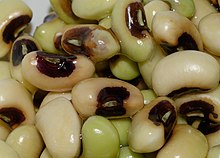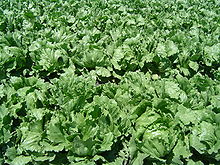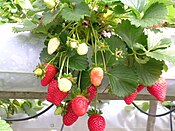Does cannabis extract obtained from cannabis flowers with maximum allowed residual level of aflatoxins and ochratoxin A have an impact on human safety and health?
F o o d
A portal dedicated to food and foodways
Introduction


Food is any substance consumed by an organism for nutritional support. Food is usually of plant, animal, or fungal origin and contains essential nutrients such as carbohydrates, fats, proteins, vitamins, or minerals. The substance is ingested by an organism and assimilated by the organism's cells to provide energy, maintain life, or stimulate growth. Different species of animals have different feeding behaviours that satisfy the needs of their metabolisms and have evolved to fill a specific ecological niche within specific geographical contexts.
Omnivorous humans are highly adaptable and have adapted to obtain food in many different ecosystems. Humans generally use cooking to prepare food for consumption. The majority of the food energy required is supplied by the industrial food industry, which produces food through intensive agriculture and distributes it through complex food processing and food distribution systems. This system of conventional agriculture relies heavily on fossil fuels, which means that the food and agricultural systems are one of the major contributors to climate change, accounting for as much as 37% of total greenhouse gas emissions. (Full article...)
Cooking, also known as cookery or professionally as the culinary arts, is the art, science and craft of using heat to make food more palatable, digestible, nutritious, or safe. Cooking techniques and ingredients vary widely, from grilling food over an open fire, to using electric stoves, to baking in various types of ovens, reflecting local conditions. Cooking is an aspect of all human societies and a cultural universal.
Preparing food with heat or fire is an activity unique to humans. Archeological evidence of cooking fires from at least 300,000 years ago exists, but some estimate that humans started cooking up to 2 million years ago.
The expansion of agriculture, commerce, trade, and transportation between civilizations in different regions offered cooks many new ingredients. New inventions and technologies, such as the invention of pottery for holding and boiling of water, expanded cooking techniques. Some modern cooks apply advanced scientific techniques to food preparation to further enhance the flavor of the dish served. (Full article...)
Angels on horseback is a hot hors d'œuvre or savoury made of oysters wrapped with bacon. The dish, when served atop breads, can also be a canapé.
The dish is typically prepared by rolling shucked oysters in bacon and baking them in an oven. Modern variations of angels on horseback include skewering and frying. Serving can vary widely to taste on either skewers or breads, with additional accompaniments or condiments. Angels on horseback differ from the similar, fruit-based, devils on horseback, but the dishes' names are sometimes erroneously considered synonyms. (Full article...)
Selected article –
The black-eyed pea or black-eyed bean is a legume grown around the world for its medium-sized, edible bean. It is a subspecies of the cowpea, an Old World plant domesticated in Africa, and is sometimes simply called a cowpea.
The common commercial variety is called the California Blackeye; it is pale-colored with a prominent black spot. The American South has countless varieties, many of them heirloom, that vary in size from the small lady peas to very large ones. The color of the eye may be black, brown, red, pink, or green. All the peas are green when freshly shelled and brown or buff when dried. A popular variation of the black-eyed pea is the purple hull pea or mud-in-your-eye pea; it is usually green with a prominent purple or pink spot. The currently accepted botanical name for the black-eyed pea is Vigna unguiculata subsp. unguiculata, although previously it was classified in the genus Phaseolus. Vigna unguiculata subsp. dekindtiana is the wild relative and Vigna unguiculata subsp. sesquipedalis is the related asparagus bean. Other beans of somewhat similar appearance, such as the frijol ojo de cabra (goat's-eye bean) of northern Mexico, are sometimes incorrectly called black-eyed peas, and vice versa. (Full article...)Selected cuisine -

Italian-American cuisine (Italian: cucina italoamericana) is a style of Italian cuisine adapted throughout the United States. Italian-American food has been shaped throughout history by various waves of immigrants and their descendants, called Italian Americans.
As immigrants from the different regions of Italy settled throughout the various regions of the United States, many brought with them a distinct regional Italian culinary tradition. Many of these foods and recipes developed into new favorites for the townspeople and later for Americans nationwide. (Full article...)Selected ingredient –

Anchovies are small, common saltwater forage fish in the family Engraulidae that are used as human food and fish bait. There are 144 species in 17 genera found in the Atlantic, Indian, and Pacific Oceans. Anchovies are usually classified as oily fish. They are small, green fish with blue reflections due to a silver longitudinal stripe that runs from the base of the caudal fin. They range from 2 centimetres (0.79 in) to 40 centimetres (16 in) in adult length, and the body shape is variable, with more slender fish in northern populations.
A traditional method of processing and preserving anchovies is to gut and salt them in brine, allow them to cure, and then pack them in oil or salt. This results in the characteristic strong flavor associated with anchovies, and their flesh turns deep grey. Anchovies pickled in vinegar, as with Spanish boquerones en vinagre, are milder, and the flesh retains a white color. For domestic use, anchovy fillets are sometimes packed in oil or salt in small tins or jars, sometimes rolled around capers. Anchovy paste is also available, as is anchovy essence. Anchovy mash is also sold in the UK under the label of Gentleman's Relish. (Full article...)
Selected recipe –
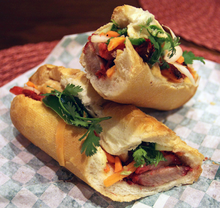
In Vietnamese cuisine, bánh mì or banh mi (/ˈbɑːn miː/, /ˈbæn/; Vietnamese: [ɓǎjŋ̟ mì], 'bread') is a short baguette with thin, crisp crust and a soft, airy texture. It is often split lengthwise and filled with meat and savory ingredients like a submarine sandwich and served as a meal, called bánh mì thịt. Plain bánh mì is also eaten as a staple food.
A typical Vietnamese roll or sandwich is a fusion of meats and vegetables from native Vietnamese cuisine such as chả lụa (Vietnamese sausage), coriander (cilantro), cucumber, pickled carrots, and pickled daikon combined with condiments from French cuisine such as pâté, along with red chili and mayonnaise. However, a variety of popular fillings are used, like xá xíu (Chinese barbecued pork), xíu mại Vietnamese minced pork, and nem nướng grilled pork sausage, to even ice cream which are more of a dessert. In Vietnam, bread rolls and sandwiches are typically eaten for breakfast, or as a snack. (Full article...)
Lettuce (Lactuca sativa) is an annual plant of the family Asteraceae. It is most often grown as a leaf vegetable, but sometimes for its stem and seeds. Lettuce is most often used for salads, although it is also seen in other kinds of food, such as soups, sandwiches and wraps; it can also be grilled. One variety, celtuce (asparagus lettuce), is grown for its stems, which are eaten either raw or cooked. In addition to its main use as a leafy green, it has also gathered religious and medicinal significance over centuries of human consumption. Europe and North America originally dominated the market for lettuce, but by the late 20th century the consumption of lettuce had spread throughout the world. As of 2021, world production of lettuce and chicory was 27 million tonnes, 53 percent of which came from China.
Lettuce was originally farmed by the ancient Egyptians, who transformed it from a plant whose seeds were used to obtain oil into an important food crop raised for its succulent leaves and oil-rich seeds. Lettuce spread to the Greeks and Romans; the latter gave it the name lactuca, from which the English lettuce is derived. By 50 AD, many types were described, and lettuce appeared often in medieval writings, including several herbals. The 16th through 18th centuries saw the development of many varieties in Europe, and by the mid-18th century, cultivars were described that can still be found in modern gardens. (Full article...)Selected image –
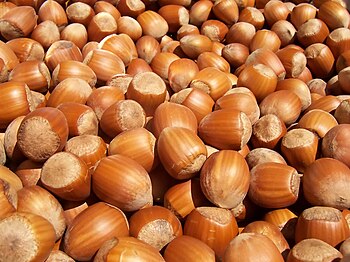
Selected biography –
B. 27 May 1975
Jamie Trevor Oliver MBE OSI (born 27 May 1975) is an English celebrity chef, restaurateur and cookbook author. He is known for his casual approach to cuisine, which has led him to front numerous television shows and open many restaurants.
Oliver reached the public eye when his series The Naked Chef premiered in 1999. In 2005, he opened a campaign, Feed Me Better, to introduce schoolchildren to healthier foods, which was later backed by the government. He was the owner of a restaurant chain, Jamie Oliver Restaurant Group, which opened its first restaurant, Jamie's Italian, in Oxford in 2008. The chain went into administration in May 2019. (Full article...)
Did you know (auto-generated) –

- ... that not all military rations are food?
- ... that in November 2022, Leicester City Council used the Food Act 1984 in combination with a royal charter of 1199 to levy a charge on the organisers of two Christmas light switching-on events?
- ... that Rosalind Creasy wrote a landmark book on edible landscaping?
- ... that the Ni'isjoohl totem pole was once fed a diet of vacuum-packed food?
- ... that British architect Diane Haigh transformed one historic building into an art gallery and another into a hospice?
- ... that the Tapuae-o-Uenuku / Hector Mountains have been an important mahinga kai (food-gathering site) for the Māori for more than 600 years?
More did you know –
Related portals
Food topics
The following are topics relating to food
Categories
Food list articles
- See also: Lists of foods and Category:Lists of drinks
The following are some Food list articles on Wikipedia:

- American cheeses
- Appellation d'Origine Contrôlée cheeses
- Apple cultivars
- Bacon dishes
- Bacon substitutes
- Basil cultivars
- Breads
- Breakfast beverages
- Breakfast cereals
- Breakfast foods
- British cheeses
- Cakes
- Candies
- Cheeses
- Cheese soups
- Christmas dishes (list)
- Cocktails
- Cookies
- Dishes using coconut milk
- Diets
- Doughnut varieties
- Egg dishes
- Fermented soy products
- Food additives
- Food additives (Codex Alimentarius)
- Foods named after people
- French cheeses
- French dishes
- Fried dough foods
- Fruits
- List of hamburgers
- Herbs and spices
- Hors d'oeuvre
- Indian dishes
- Indian snack foods
- Indonesian dishes
- Italian dishes
- Japanese snacks
- Japanese dishes
- Jewish dishes
- Kebabs
- Korean beverages
- Mango cultivars
- Moroccan dishes
- Pasta
- Pastries
- Philippine snack food
- Pies, tarts and flans
- Poppy seed pastries and dishes
- Potato dishes
- Puddings
- Raw fish dishes
- Rice dishes
- Rolled foods
- Sauces
- Seafood
- Seeds
- Sandwiches
- Snack foods
- Soft drinks by country
- Soul foods and dishes
- Soups
- Stews
- Street foods
- Tapas
- Turkish dishes
- Twice-baked foods
- Vegetable oils
- Vegetables
- Vodkas
Things you can do
Related WikiProjects
| Parent project: WikiProject Food and Drink | |
| Child projects: | Task forces: (All inactive) |
|
|
| Related projects: | |
New articles
Rules | Match log | Results page (for watching) | Last updated: 2024-09-09 19:20 (UTC)
Note: The list display can now be customized by each user. See List display personalization for details.
- 3-in-1 (fast food dish) ( | talk | history | links | watch | logs | tools) by Bogger (talk · contribs · new pages (24)) started on 2024-09-09, score: 30
- Idle Hour Café ( | talk | history | links | watch | logs | tools) by Gb321 (talk · contribs · new pages (10)) started on 2024-09-09, score: 10
- Rum raisin ( | talk | history | links | watch | logs | tools) by Jake Choke (talk · contribs · new pages (1)) started on 2024-09-09, score: 50
- Cereal for Dinner ( | talk | history | links | watch | logs | tools) by GobsPint (talk · contribs · new pages (8)) started on 2024-09-08, score: 20
- Zaharakos Ice Cream Parlor ( | talk | history | links | watch | logs | tools) by Valereee (talk · contribs · new pages (6)) started on 2024-09-08, score: 10
- Flavor cocoa ( | talk | history | links | watch | logs | tools) by Rollinginhisgrave (talk · contribs · new pages (10)) started on 2024-09-08, score: 10
- Maximilian Kilman ( | talk | history | links | watch | logs | tools) by Killarnee (talk · contribs · new pages (19)) started on 2024-09-08, score: 10
- Spiro Spathis ( | talk | history | links | watch | logs | tools) by A09 (talk · contribs · new pages (4)) started on 2024-09-08, score: 10
- Types of cocoa beans ( | talk | history | links | watch | logs | tools) by Rollinginhisgrave (talk · contribs · new pages (10)) started on 2024-09-08, score: 30
- Bulk cocoa ( | talk | history | links | watch | logs | tools) by Rollinginhisgrave (talk · contribs · new pages (10)) started on 2024-09-08, score: 10
- West Virginia Hot Dog Festival ( | talk | history | links | watch | logs | tools) by Samz73428091 (talk · contribs · new pages (25)) started on 2024-09-08, score: 10
- Legal definitions of chocolate ( | talk | history | links | watch | logs | tools) by Rollinginhisgrave (talk · contribs · new pages (10)) started on 2024-09-07, score: 10
- King Island Dairy ( | talk | history | links | watch | logs | tools) by Pidzz (talk · contribs · new pages (11)) started on 2024-09-07, score: 10
- Whole Foods ( | talk | history | links | watch | logs | tools) by Turnoffthat (talk · contribs · new pages (2)) started on 2024-09-07, score: 10
- Torno Subito ( | talk | history | links | watch | logs | tools) by Another Believer (talk · contribs · new pages (141)) started on 2024-09-07, score: 10
- Armani Ristorante ( | talk | history | links | watch | logs | tools) by Another Believer (talk · contribs · new pages (141)) started on 2024-09-07, score: 10
- Trèsind Studio ( | talk | history | links | watch | logs | tools) by Another Believer (talk · contribs · new pages (141)) started on 2024-09-07, score: 10
- Avatāra (restaurant) ( | talk | history | links | watch | logs | tools) by Another Believer (talk · contribs · new pages (141)) started on 2024-09-07, score: 10
- Sagetsu by Tetsuya ( | talk | history | links | watch | logs | tools) by Another Believer (talk · contribs · new pages (141)) started on 2024-09-07, score: 10
- Hōseki ( | talk | history | links | watch | logs | tools) by Another Believer (talk · contribs · new pages (141)) started on 2024-09-07, score: 10
- Talea by Antonio Guida ( | talk | history | links | watch | logs | tools) by Another Believer (talk · contribs · new pages (141)) started on 2024-09-07, score: 10
- 99 Sushi Bar ( | talk | history | links | watch | logs | tools) by Another Believer (talk · contribs · new pages (141)) started on 2024-09-07, score: 10
- Erth (restaurant) ( | talk | history | links | watch | logs | tools) by Another Believer (talk · contribs · new pages (141)) started on 2024-09-07, score: 10
- Cadbury Favourites ( | talk | history | links | watch | logs | tools) by Panamitsu (talk · contribs · new pages (5)) started on 2024-09-02, score: 20
- Brewmaster: Beer Brewing Simulator ( | talk | history | links | watch | logs | tools) by NinjaRobotPirate (talk · contribs · new pages (11)) started on 2024-09-06, score: 10
- Tempering chocolate ( | talk | history | links | watch | logs | tools) by Rollinginhisgrave (talk · contribs · new pages (10)) started on 2024-09-06, score: 20
- Mason Montgomery ( | talk | history | links | watch | logs | tools) by Yankees10 (talk · contribs · new pages (23)) started on 2024-09-05, score: 10
- Mikado cake ( | talk | history | links | watch | logs | tools) by Athoremmes (talk · contribs · new pages (2)) started on 2024-09-05, score: 20
- William McCormick (physician) ( | talk | history | links | watch | logs | tools) by Ysh.cabana (talk · contribs · new pages (1)) started on 2024-09-05, score: 10
- Ramen Danbo ( | talk | history | links | watch | logs | tools) by Another Believer (talk · contribs · new pages (141)) started on 2024-09-02, score: 10
- Hans Lüdemann ( | talk | history | links | watch | logs | tools) by 4meter4 (talk · contribs · new pages (169)) started on 2024-09-05, score: 10
- Shutki shira ( | talk | history | links | watch | logs | tools) by Jaunpurzada (talk · contribs · new pages (2)) started on 2024-09-05, score: 10
- Chayan Yuese ( | talk | history | links | watch | logs | tools) by Pieceofmetalwork (talk · contribs · new pages (5)) started on 2024-09-05, score: 10
- Unilever Israel ( | talk | history | links | watch | logs | tools) by אקסינו (talk · contribs · new pages (10)) started on 2024-09-04, score: 20
- Seth W. Hancock ( | talk | history | links | watch | logs | tools) by Jnglmpera (talk · contribs · new pages (1)) started on 2024-09-04, score: 10
- Pure Food and Wine ( | talk | history | links | watch | logs | tools) by Another Believer (talk · contribs · new pages (141)) started on 2024-09-04, score: 10
- Honey deuce ( | talk | history | links | watch | logs | tools) by Fortunaa (talk · contribs · new pages (1)) started on 2024-09-04, score: 20
- Kristal (drink) ( | talk | history | links | watch | logs | tools) by אקסינו (talk · contribs · new pages (10)) started on 2024-09-03, score: 20
- Logan Driscoll ( | talk | history | links | watch | logs | tools) by Muboshgu (talk · contribs · new pages (7)) started on 2024-08-31, score: 10
- The Detective Wore Silk Drawers ( | talk | history | links | watch | logs | tools) by Lord Cornwallis (talk · contribs · new pages (78)) started on 2024-09-03, score: 10
- Feastogether ( | talk | history | links | watch | logs | tools) by Cunard (talk · contribs · new pages (6)) started on 2024-09-03, score: 20
- Chili's at 45th and Lamar ( | talk | history | links | watch | logs | tools) by TerraFrost (talk · contribs · new pages (1)) started on 2024-09-02, score: 10
- Overeem Whisky ( | talk | history | links | watch | logs | tools) by Abbaskip (talk · contribs · new pages (2)) started on 2024-08-30, score: 20
- The Alley (restaurant) ( | talk | history | links | watch | logs | tools) by Another Believer (talk · contribs · new pages (141)) started on 2024-09-02, score: 10
- Teaspoon (restaurant) ( | talk | history | links | watch | logs | tools) by Another Believer (talk · contribs · new pages (141)) started on 2024-09-02, score: 10
- Saemaeul Restaurant ( | talk | history | links | watch | logs | tools) by Seefooddiet (talk · contribs · new pages (51)) started on 2024-09-02, score: 10
- Contramar ( | talk | history | links | watch | logs | tools) by Heroeswithmetaphors (talk · contribs · new pages (13)) started on 2024-09-02, score: 20
- Happy Lemon ( | talk | history | links | watch | logs | tools) by Another Believer (talk · contribs · new pages (141)) started on 2024-09-02, score: 10
- Sharetea ( | talk | history | links | watch | logs | tools) by Another Believer (talk · contribs · new pages (141)) started on 2024-09-02, score: 10
- Umu (restaurant) ( | talk | history | links | watch | logs | tools) by Another Believer (talk · contribs · new pages (141)) started on 2024-09-02, score: 10
- Jamavar (restaurant) ( | talk | history | links | watch | logs | tools) by Another Believer (talk · contribs · new pages (141)) started on 2024-09-02, score: 10
- Dorian (restaurant) ( | talk | history | links | watch | logs | tools) by Another Believer (talk · contribs · new pages (141)) started on 2024-09-02, score: 10
- Oxbow (restaurant) ( | talk | history | links | watch | logs | tools) by Another Believer (talk · contribs · new pages (141)) started on 2024-08-31, score: 10
- Cornitos ( | talk | history | links | watch | logs | tools) by Atulkumar.1990 (talk · contribs · new pages (2)) started on 2024-08-30, score: 40
- Generation Loss (novel) ( | talk | history | links | watch | logs | tools) by Czar (talk · contribs · new pages (14)) started on 2024-09-01, score: 10
- Jo Jeong-du ( | talk | history | links | watch | logs | tools) by Fixer88 (talk · contribs · new pages (124)) started on 2024-08-30, score: 10
- Caloglossa beccarii ( | talk | history | links | watch | logs | tools) by Mbdfar (talk · contribs · new pages (26)) started on 2024-08-29, score: 10
- Fernanda Fuentes Cardenas ( | talk | history | links | watch | logs | tools) by ProudWatermelon (talk · contribs · new pages (16)) started on 2024-08-27, score: 20
- Ostrich meat ( | talk | history | links | watch | logs | tools) by Angelbmartin (talk · contribs · new pages (3)) started on 2024-08-29, score: 10
- Caloglossa ( | talk | history | links | watch | logs | tools) by Mbdfar (talk · contribs · new pages (26)) started on 2024-08-29, score: 10
- Fried onion burger ( | talk | history | links | watch | logs | tools) by Valereee (talk · contribs · new pages (6)) started on 2024-08-29, score: 30
- Esben Lunde Larsen ( | talk | history | links | watch | logs | tools) by Liq Siq Giq 41q (talk · contribs · new pages (2)) started on 2024-08-29, score: 10
- Seed oil controversy ( | talk | history | links | watch | logs | tools) by DoubleGrazing (talk · contribs · new pages (33)) started on 2024-08-29, score: 10
- Watermelon milk ( | talk | history | links | watch | logs | tools) by Heeheemalu (talk · contribs · new pages (2)) started on 2024-08-29, score: 20
- Ultra-Processed People ( | talk | history | links | watch | logs | tools) by Folkezoft (talk · contribs · new pages (14)) started on 2024-08-28, score: 20
- Forest Side (restaurant) ( | talk | history | links | watch | logs | tools) by Another Believer (talk · contribs · new pages (141)) started on 2024-08-28, score: 10
- Sitajakhala ( | talk | history | links | watch | logs | tools) by Saurabhsaha (talk · contribs · new pages (9)) started on 2024-08-23, score: 10
- Dinner Train (Netherlands) ( | talk | history | links | watch | logs | tools) by Thief-River-Faller (talk · contribs · new pages (40)) started on 2024-08-28, score: 10
- Food Arts ( | talk | history | links | watch | logs | tools) by Thriley (talk · contribs · new pages (66)) started on 2024-08-28, score: 30
- Le Fournil ( | talk | history | links | watch | logs | tools) by Another Believer (talk · contribs · new pages (141)) started on 2024-08-28, score: 10
- Sledging ration ( | talk | history | links | watch | logs | tools) by Mbdfar (talk · contribs · new pages (26)) started on 2024-08-27, score: 10
- Olho de sogra ( | talk | history | links | watch | logs | tools) by Cathodography (talk · contribs · new pages (1)) started on 2024-08-26, score: 50
- Uncovered liquids ( | talk | history | links | watch | logs | tools) by TheRabbi613 (talk · contribs · new pages (3)) started on 2024-08-26, score: 10
- Proud Mary Coffee ( | talk | history | links | watch | logs | tools) by Another Believer (talk · contribs · new pages (141)) started on 2024-08-26, score: 10
- Uncovered Liquids ( | talk | history | links | watch | logs | tools) by TheRabbi613 (talk · contribs · new pages (3)) started on 2024-08-26, score: 10
- Saphobius brouni ( | talk | history | links | watch | logs | tools) by AxonsArachnida (talk · contribs · new pages (87)) started on 2024-08-26, score: 10
- Agriculture (ants) ( | talk | history | links | watch | logs | tools) by AgisdeSparte (talk · contribs · new pages (4)) started on 2024-08-25, score: 10
Associated Wikimedia
The following Wikimedia Foundation sister projects provide more on this subject:
-
 Commons
Commons
Free media repository -
 Wikibooks
Wikibooks
Free textbooks and manuals -
 Wikidata
Wikidata
Free knowledge base -
 Wikinews
Wikinews
Free-content news -
 Wikiquote
Wikiquote
Collection of quotations -
 Wikisource
Wikisource
Free-content library -
 Wikiversity
Wikiversity
Free learning tools -
 Wiktionary
Wiktionary
Dictionary and thesaurus




































